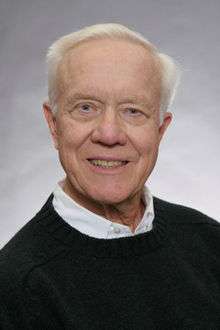Nils John Nilsson
| Nils John Nilsson | |
|---|---|
 | |
| Born | 1933 (age 82–83) |
| Nationality | American |
| Fields | Artificial intelligence |
| Institutions |
SRI International Stanford University |
| Alma mater | Stanford University |
| Doctoral advisor | Willis Harman |
| Doctoral students |
Leslie P. Kaelbling Andrew Kosoresow Karen Myers |
Nils John Nilsson (born 1933) is an American computer scientist. He is one of the founding researchers in the discipline of artificial intelligence. He is the first Kumagai Professor of Engineering (Emeritus) in Computer Science at Stanford University, position that he held since the chair was established in 1990 through 1995. He is particularly famous for his contributions to search, planning, knowledge representation, and robotics.
His research has been based mainly on the premise that intelligence is based on knowledge that must be represented explicitly.
Early life and education
Nilsson received his Ph.D. from Stanford in 1958, and spent much of his career at SRI International, a private research lab spun off from Stanford.
Career
SRI International
Starting in 1966, Nilsson, along with Charles A. Rosen and Bertram Raphael, led a research team in the construction of Shakey, a robot that constructed a model of its environment from sensor data, reasoned about that environment to arrive at a plan of action, then carried that plan out by sending commands to its motors. This paradigm has been enormously influential in AI. (Textbooks such as (Charniak & McDermott 1985), (Ginsberg 1993) and the first edition of (Russell & Norvig 1992) show this influence in almost every chapter, although the entire field has not always stayed under its spell.) Although the basic idea of using logical reasoning to decide on actions is due to John McCarthy (McCarthy), Nilsson's group was the first to embody it in a complete agent, along the way inventing the A* search algorithm (Hart, Nilsson & Raphael 1968) and founding the field of automated temporal planning. In the latter pursuit, they invented the STRIPS planner (Fikes & Nilsson 1971), whose action representation is still the basis of many of today's planning algorithms. The subfield of automated temporal planning called classical planning is based on most of the assumptions built into STRIPS.
Stanford University
In 1985 Nilsson became a faculty member at Stanford University, in the Computer Science Department. He was chair of the department from 1985 to 1990. He was the fourth President of the AAAI (1982–83) and a Founding Fellow of that organization. Nilsson has written or coauthored several books on AI, including two that have been especially widely read (Nilsson 1980, Genesereth & Nilsson 1987).
Awards and memberships
In 2011, Nilsson was inducted into IEEE Intelligent Systems' AI's Hall of Fame for the "significant contributions to the field of AI and intelligent systems".[1][2]
References
- ↑ "AI's Hall of Fame" (PDF). IEEE Intelligent Systems. IEEE Computer Society. 26 (4): 5–15. 2011. doi:10.1109/MIS.2011.64.
- ↑ "IEEE Computer Society Magazine Honors Artificial Intelligence Leaders". DigitalJournal.com. August 24, 2011. Retrieved September 18, 2011. Press release source: PRWeb (Vocus).
Further reading
- Charniak, Eugene; McDermott, Drew (1985), Introduction to Artificial Intelligence, Reading, Mass.: Addison-Wesley
- Fikes, Richard; Nilsson, Nils (1971), "STRIPS: A new approach to the application of theorem proving to problem solving", Artificial Intelligence, 2: 189–208, doi:10.1016/0004-3702(71)90010-5
- Genesereth, Michael; Nilsson, Nils (1987), Logical Foundations of Artificial Intelligence, Los Altos, CA: Morgan Kaufmann
- Ginsberg, Matthew (1993), Essentials of Artificial Intelligence, Morgan Kaufmann Publishers Inc.
- Hart, P. E.; Nilsson, N. J.; Raphael, B. (1968), "A Formal Basis for the Heuristic Determination of Minimum Cost Paths" (PDF), IEEE Transactions on Systems Science and Cybernetics SSC4, 4 (2): 100–107, doi:10.1109/TSSC.1968.300136 Cite uses deprecated parameter
|coauthors=(help)
- McCarthy, John ((Minsky 1968), pp. 403-418) [1960], "Programs with common sense", Proceedings of the Teddington Conference on the Mechanization of Thought Processes, London: Her Majesty's Stationery Office Check date values in:
|date=(help)
- Nilsson, Nils (1980), Principles of Artificial Intelligence., Palo Alto: Tioga Publishing Company
- Russell, Stuart; Norvig, Peter (1992), Artificial Intelligence: A Modern Approach (1st ed.), Prentice Hall
External links
- Nilsson's home page
- Nils John Nilsson at the Mathematics Genealogy Project
- Nils J. Nilsson at the AI Genealogy Project.
- Oral history interview with Nils J. Nilsson, Charles Babbage Institute, University of Minnesota, Minneapolis. Nilsson gives an overview of DARPA-sponsored AI research at SRI, including his own work in robotics (especially during the period 1966-1971), research on the Computer Based Consultant, and related research on natural language and speech understanding. He describes the significance and relationship of robotics to the larger field of AI, particularly the intellectual problems it addressed and the enabling technologies it helped develop.